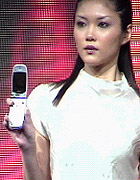Cell-Phone Inventor Touts Broadband Wireless
 In 1973 Martin Cooper, the inventor of the first portable handset, was the first person to make a call on a cell phone (from Motorola to arch-rival Bell.) Now he’s Chairman of ArrayComm, which has developed its iBurst Personal Broadband System based on adaptive array antenna technology. According to the company, iBurst allows mega-bit-per-second cellular bandwidth with much better efficiency than anything extant 3G systems can provide. In today’s exclusive WWJ interview, Cooper argues that 4G is already here; launches broadsides at carriers, engineers, and handset makers who have yet to fulfill the promise of wireless phones; and charges that, after “years of hype,” the industry has failed to deliver on 3G. He also relates his vision for the mobile space: “The Internet will engender thousands of different [mobile] applications.” This interview is a WWJ Classic. Full Program Run-time 17:38
In 1973 Martin Cooper, the inventor of the first portable handset, was the first person to make a call on a cell phone (from Motorola to arch-rival Bell.) Now he’s Chairman of ArrayComm, which has developed its iBurst Personal Broadband System based on adaptive array antenna technology. According to the company, iBurst allows mega-bit-per-second cellular bandwidth with much better efficiency than anything extant 3G systems can provide. In today’s exclusive WWJ interview, Cooper argues that 4G is already here; launches broadsides at carriers, engineers, and handset makers who have yet to fulfill the promise of wireless phones; and charges that, after “years of hype,” the industry has failed to deliver on 3G. He also relates his vision for the mobile space: “The Internet will engender thousands of different [mobile] applications.” This interview is a WWJ Classic. Full Program Run-time 17:38


 Last December, DoCoMo unveiled its new 900i series phones in a
Last December, DoCoMo unveiled its new 900i series phones in a  “We know what kind of contents sell, we know what the customers want and we can create a great user experience for the users on the networks,” says
“We know what kind of contents sell, we know what the customers want and we can create a great user experience for the users on the networks,” says  “The single biggest benefit that was discovered in Japan was that you need to be fair in sharing the revenues with the content developer. It is not fair to say to a Disney or a CNN, ‘Give me half your money, and then I will put you on my network.’ DoCoMo approached this with the rough idea they would like to keep 10% and give the content developer 90%,” says
“The single biggest benefit that was discovered in Japan was that you need to be fair in sharing the revenues with the content developer. It is not fair to say to a Disney or a CNN, ‘Give me half your money, and then I will put you on my network.’ DoCoMo approached this with the rough idea they would like to keep 10% and give the content developer 90%,” says  The
The  Tune in for a WWJ exclusive year-end interview with IDC Japan Communication Research Division’s Senior Analyst Michito (Mitch) Kimura. In this video program, Kimura, a veteran IDC analyst, casts his eyes on the ups and downs over the last year in the world of wireless and takes a look at prospects for 2004. He details the strategy at Japan’s three carriers, NTT DoCoMo, KDDI, and Vodafone, and offers his view on the prospects for Japan’s ever-surging content business. Kimura-san also gave us his perspective on the continued evolution of 3G, handset replacement cycles, and – a favorite topic of ours – Japan’s first packet pricing war.
Tune in for a WWJ exclusive year-end interview with IDC Japan Communication Research Division’s Senior Analyst Michito (Mitch) Kimura. In this video program, Kimura, a veteran IDC analyst, casts his eyes on the ups and downs over the last year in the world of wireless and takes a look at prospects for 2004. He details the strategy at Japan’s three carriers, NTT DoCoMo, KDDI, and Vodafone, and offers his view on the prospects for Japan’s ever-surging content business. Kimura-san also gave us his perspective on the continued evolution of 3G, handset replacement cycles, and – a favorite topic of ours – Japan’s first packet pricing war.